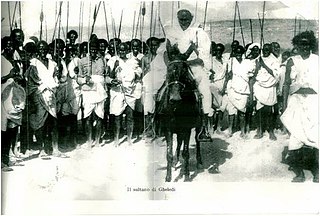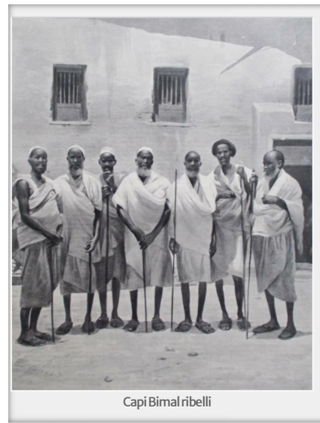Somalia, officially the Federal Republic of Somalia and formerly known as the Somali Democratic Republic, is a country located in the Horn of Africa. The country was an important centre for commerce with the rest of the ancient world, and according to most scholars, it is among the most probable locations of the fabled ancient Land of Punt. During the Middle Ages, several powerful Somali states and port towns dominated the regional trade, the Mogadishu Sultanate and Ajuran Sultanate both centered around the port town Mogadishu, but also the port towns of Barawe and Merca.

British Somaliland, officially the Somaliland Protectorate, was a British protectorate in present-day Somaliland. During its existence, the territory was bordered by Italian Somalia, French Somali Coast and Abyssinia. From 1940 to 1941, it was occupied by the Italians and was part of Italian East Africa.

Italian Somaliland was a protectorate and later colony of the Kingdom of Italy in present-day Somalia. Ruled in the 19th century by the Somali Sultanates of Hobyo and Majeerteen in the north, and the Hiraab Imamate and Geledi Sultanate and the Biimaal Sultanate leading a resistance against the colonials in southern Somalia for decades. The territory was acquired in the 1880s by Italy through various treaties.

Merca is a historic port city in the southern Lower Shebelle province of Somalia. It is located approximately 109 km (68 mi) to the southwest of the nation's capital Mogadishu. Merca is the traditional home territory of the Major Bimal clan and was the center of the Bimal revolt.
The Dhulbahante is a Somali clan family, part of the Harti clan which itself belongs to the largest Somali clan-family — the Darod. They are the traditional inhabitants of the physiographic Nugaal in its topographic sense, and its pre-independence administrative sense, which included Doollo. The clan's progenitor is buried at Badweyn.

The Hawiye is the largest Somali clan family. Members of this clan traditionally inhabit central and southern Somalia, Somaliland, Ethiopia and the North Eastern Province in Kenya. They are also the majority in the capital city, Mogadishu.
Abdi Mohamed Kusow is a Somali scholar and writer.

Sayid Mohamed Abdullahi Hassan was a Somali religious and military leader of the Dervish movement, which led a two-decade long confrontation with various colonial empires including the British, Italians, and Ethiopians.
The Banaadiri people are a nationality in Somalia. Banaadiris largely inhabit Somalia's southern coastline.
Ahmed Yusuf Mahamud was a Somali ruler. He was the fourth Sultan of the Geledi sultanate, reigning from 1848 to 1878 and succeeded his father Yusuf Mahamud after his demise at the battle of Adaddey Suleyman. Ahmed's rule marked a period of great prosperity in the Sultanate and with his death in 1878 the Geledi decline began.the sultan was credited as having brought over 20,000 Somali troops to free the slaves of zanzibar.

The Dervish Movement was a popular movement between 1899 and 1920, which was led by the Salihiyya Sufi Muslim poet and militant leader Mohammed Abdullah Hassan, also known as Sayyid Mohamed, who called for independence from the British and Italian colonies and the defeat of Ethiopian forces. The Dervish movement aimed to remove the British and Italian influence from the region and restore the "Islamic system of government with Islamic education as its foundation", according to Mohamed-Rahis Hasan and Salada Robleh.

Osman Ahmed was a Somali ruler. He was the fifth and final Sultan of the Geledi Sultanate. Osman Ahmed is considered less illustrious than his predecessors and Gobroon power weakened considerably under his rule. He was the son of Sultan Ahmed Yusuf and succeeded his father after his death. Although, considerably weaker than his forebearers he was still the most powerful ruler in the region and was credited for defending the Reewing territory by repulsing an invasion from the Ethiopian Empire and Dervish State.

The Royal Corps of Somali Colonial Troops was the colonial body of the Royal Italian Army based in Italian Somaliland, in present-day northeastern, central and southern Somalia.

Sheikh Abdi Abukar Gaafle, Somali:, was a leader of the Biimaal Revolt against Italian occupation of southern Somalia. Born in Armadow (Ceelwareegow) near Marka District, Somalia in 1852, he died in 1922 in Laantabuur, Raaxoole District, Somalia. He is described as one of the best known resistance leaders in the history of southern Somalia.
The 12 Koofi, more commonly known as Reer Marka, are a Somali confederation of clans inhabiting the city of Merca and other southern coastal towns of Somalia.
Juunji are a Benadiri/12 Koofi clan mainly from the southern coastal city of Marka.
Fasahale more commonly known as Kafaari are a Benadiri/12 Koofi clan mainly from the southern coastal city of Marka.
The Mohamoud Garad is a Somali clan. Its members form a part of the Dhulbahante, a sub-division of the Harti/Darod clan-family. The clan is divided into three main sub-clans ― namely the Jama Siad, the Ugaadhyahan and Omar Wa’eys.
The Farah Garad or the Garad Farah is a Somali clan which is part of the Dhulbahante clan-family, a sub-division of the larger Harti/Darod clan. The Farah Garad are divided into two sub-clans — Yassin Garad and Abdalla Garad. Abdalla has three clan eponyms, Ahmed Garad, Baharsame and Barkad. The large chief caaqil agglomerations including Ararsame, or the Ali Gheri xeer group,. And Yassin Dia Group.













